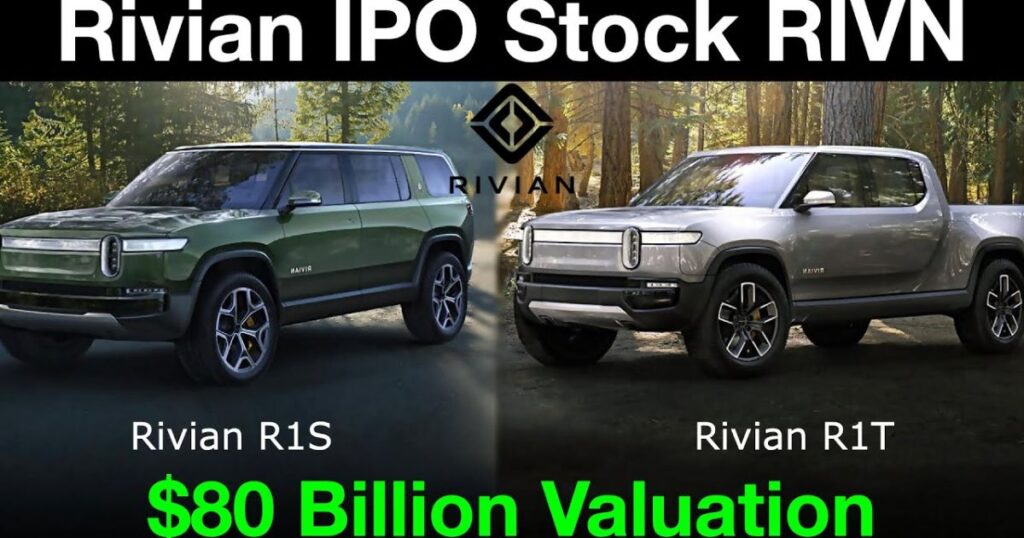After reaching its lowest point in May Rivian stock showed signs of stabilization in recent weeks closing just below $40 on Monday. This follows the electric vehicle maker reporting its highest monthly production total to date in June. Rivian said it produced over 5,000 vehicles last month driven by improvements in its manufacturing capabilities and supply chain.
However shares remain volatile as investors weigh near term production risks against long-term growth potential. One notable positive is Rivian securing a new supply agreement that will provide it with enough battery cells for approximately 250,000 vehicles per year by 2025. This helps bolster its efforts to ramp up production and address the massive backlog of around 90,000 pre-orders for its R1T pickup and R1S SUV models.
With Rivian Stock The Rise Of Rivian
Rivian Automotive, Inc. designs, develops, manufactures and sells electric vehicles and accessory equipment. Founded in 2009 Rivian is one of the leading manufacturers of electric vehicles. Some key facts about Rivian:
- Rivian unveiled its first two electric vehicles the R1T electric pickup truck and R1S electric SUV, in 2018.
- The R1T was the first electric pickup truck to arrive on the market.
- In 2021 Rivian began production and deliveries of its vehicles from its factory in Normal Illinois.
- Major investors in Rivian include Amazon, which has ordered 100,000 electric delivery vehicles from Rivian to be delivered by 2030. Ford is also a large shareholder.
- Rivian went public in November 2021 with one of the largest IPOs of the year raising over $12 billion at a valuation of over $76 billion.
Fintechzoom Rivian Stock: Financial Analysis
Let’s take a closer look at Rivian’s financials:
In Q1 2022, Rivian generated $95 million in revenue from delivering 1,227 vehicles. It reported a net loss of $1.59 billion as it ramps up production.
Production in 2022 is expected to reach 25,000 vehicles as it expands production capacity. Rivian has a backlog of over 90,000 pre orders.
Rivian had $17 billion in cash and equivalents as of March 2022 providing a strong cash position to fund ongoing operations and expansion plans.
However, operating expenses are also high as the company invests heavily in R&D, manufacturing facilities and production capacity expansion.
Rivian has major supply chain contracts in place including a battery supply deal with Samsung SDI. However, like other automakers it faces component shortages and rising costs.
Performance Of Rivian Stocks On Fintechzoom
Let’s take a look at how RIVN stock has performed since its IPO on Fintechzoom:
- Rivian stock opened at $106.75/share on its first day of trading in November 2021.
- It quickly rose to a high of $179/share in mid November as investor demand was strong. This gave Rivian a market cap over $100 billion.
- However, from late November the stock entered a downtrend amid broader electric vehicle sector weakness and profit-taking.
- By 2023, RIVN fell below its IPO price ranging between $25-50/share as production delays and costs weighed.
- Currently, Rivian stock trades around $33/share down over 70% from its peak but up modestly from its lowest levels.
- On Fintechzoom, RIVN now has a market cap of around $30 billion down significantly from its peak but still sizable for a young startup.
Rivian’s Market Position and Recent Developments
Some key points on Rivian’s market position and recent updates:
- Rivian competes primarily in the growing electric pickup and SUV markets against rivals like Tesla, Ford F-150 Lightning, and GMC Hummer EV.
- In Q1 2022, Rivian ramped production to 2,553 vehicles as it works to fulfill pre orders and dealer allocations.
- The company announced plans to build a second U.S. assembly plant for $5 billion in Georgia with annual capacity of 400,000 vehicles.
- Parts shortages remain a challenge. Rivian was forced to halt production for a month in March to reallocate parts.
- In late 2022, Rivian launched a content subscription service for infotainment, digital experiences, and over-the-air updates.
- Revenue is expected to grow substantially in 2023 as production volumes increase and the subscription service adds recurring sales.
Financial Performance and Earnings Reports

Let’s review Rivian’s latest quarterly earnings report:
- In Q2 2022, Rivian’s revenue was $364 million from producing 4,401 vehicles up from $339k a year ago.
- The net loss widened to $1.71 billion from $580 million a year ago as costs increased.
- Operating expenses rose to $1.7 billion from $937 million a year ago as R&D, SG&A and production ramp up costs increased.
- Cash and equivalents fell to $13.8 billion from $17 billion in Q1 as cash was used to fund production/growth.
- Full year 2022 production guidance was maintained at 25,000 units, though supply issues remain a challenge and upside risk.
- Rivian expects to break even on an EBITDA basis by 2025 as production volumes/scale increases margins over time.
Analyst Ratings and Market Sentiment
Let’s look at Wall Street analysts views and market sentiment toward Rivian:
- Of 13 analysts covering RIVN stock 8 rate it a Buy and 5 a Hold with an average price target of $50/share.
- Bullish analysts cite Rivian’s strong brand, industry leading products and contracts with Amazon as advantages for long term growth.
- Bears point to scale-up challenges, rising costs and a path to profitability dependent on high sales growth amid macro uncertainty.
- Short interest in RIVN makes up around 25% of its free float indicating continued skepticism among some investors over production/execution risks.
- Options traders have a neutral outlook with upside calls balanced by downside put open interest through year end. Volatility remains elevated.
- Generally, sentiment is that Rivian offers high risk but also high reward potential if it can capitalize on its brand and manufacturing capabilities.
Rivian Stock Performance Since Ipo
As discussed earlier Rivian stock performance has been volatile since its IPO in November 2021:
- Strong investor demand saw shares open over 100% above the IPO price of $78 and initially gain further.
- However, from late 2021 the stock trended lower amid broader EV sector weakness and profit-taking from highs.
- By January 2023, RIVN fell below its IPO price finding support around $25-35/share in the following months.
- Upsides have come on better than expected quarterly reports or optimistic production/delivery outlooks.
- Downsides tend to occur on missed estimates, production delays, negative sell side analyst actions or broader market declines.
- Currently RIVN trades around $33 well off highs but up from lowest levels as it executes on production scale up through 2023.
- Long-term performance will depend on Rivian’s ability to launch new vehicles, continue scaling up, achieve cost reductions and gain market share in the growing EV space.
Factors Affecting Rivian Stocks
Some key factors that influence trading in Rivian stocks include:
- Vehicle production and delivery numbers: Beating or missing targets can move the stock.
- Supply chain issues: Any impacts of shortages that delay production receive negative reactions.
- Margins and pathway to profitability: As costs remain high, investors watch the timeline to break-even.
- Cash reserves and liquidity: Ensuring adequate funding to support growth plans eases concerns.
- New model launches: Successful introductions like additional SUV/truck variants boost appeal.
- Competition from rivals: Gains or losses of market share impact perceived leadership position.
- Analyst commentary and ratings changes: Upgrades lift shares, downgrades add pressure.
- Macroeconomic conditions: Recession fears or inflation worries curb risk appetite for growth stocks.
Careful execution across these factors remains key for Rivian to maintain investor confidence.
Comparison Of Rivian Stocks With Market Giants
Let’s compare Rivian’s financials and market performance to industry leaders:
| Company | Market Cap | Revenue (TTM) | EPS (TTM) | YTD Stock Return |
| Tesla | 702B | 67.2B | 4.10 | -54.6% |
| GM | 55B | 137B | 5.71 | -43.3% |
| Ford | 58B | 136B | 1.81 | -39.9% |
| Lucid | 26B | 227M | -4.67 | -67.4% |
| Rivian | 28B | 356M | -20.35 | -76.7% |
As the table shows, Rivian trades at a lower valuation relative to its limited production and sales revenues versus automotive giants and Tesla. Its negative earnings also reflect the investments required to scale operations in a capital-intensive industry during a period of rising costs. Growth potential means it could eventually perform more like Tesla if production and sales milestones are achieved.
The Rise Of Rivian
Electric vehicles are experiencing tremendous growth as consumers increasingly gravitate towards sustainable transportation options. Several factors have contributed to the rise of Rivian within this expanding industry:
Growing environmental awareness is pushing automakers to invest heavily in EVs. Rivian has positioned itself at the forefront of this industry transition.
High gas prices are making consumer more sensitive to fuel costs benefiting EVs with their lower operating expenses over the lifetime of the vehicle.
As battery technology advances EVs are achieving longer ranges and becoming more practical for everyday use cases. Rivian’s vehicles offer leading range among pickup and SUV competitors.
Government incentives in the US and abroad are helping to lower the upfront cost of EVs and bring them further into price parity with gas alternatives. These programs support greater EV adoption.
Major corporate and fleet customers like Amazon want sustainable delivery vehicles, creating offtake agreements that help de-risk the early stages of Rivian’s production ramp.
What is The Prospect Of Rivian Stock?

The future prospect of Rivian stock will depend largely on the company’s execution in the coming years:
- Production capacity expansions on track could see annual volumes rise above 200,000 by 2025-2026 if market demand remains strong.
- New vehicles in additional categories like commercial vans keep the product pipeline fresh. International expansion broadens the total addressable market.
- Supply chain management maintains steady component inflows and avoids further cost-increasing production disruptions.
- Operating margins gradually improve as fixed costs are spread over a higher volume basis and manufacturing efficiencies increase.
- Revenue grows substantially through new vehicle sales as well as the vehicle as a service subscriptions introduced in late 2022.
- Positive cash flow and profits appear on the horizon by 2025 as projected instilling greater financial stability.
- Growing consumer availability and recognition of the Rivian brand strengthens market share, especially in affluent outdoor/adventure demographic segments.
If Rivian hits these milestones over the next 3-5 years its stock could certainly perform well from current levels. However, setbacks remain a significant risk given the challenges of scaling a new car company.
What is The Projected Growth For Rivian Stock?
Based on bullish assumptions around Rivian achieving strong production growth targets and a path to profitability by 2025-2026 here are some potential stock price projections:
- By end of 2023: $45-55/share. Production reaches 50,000 units and early operating leverage begins contributing to lower losses.
- End of 2024: $65-75/share. Annual production exceeds 100,000 vehicles, first signs of positive EBITDA as costs decline on scale.
- End of 2025: $85-95/share. Annual production of 150,000-200,000, net income turns positive and operating margins trend upwards.
- End of 2026: $115-125/share. Annual production exceeds 200,000 with additional capacity. Favorable comparisons to industry leaders on profitable growth.
- End of 2027: $150-165/share. Production maintaining strong volumetrends. Rivian establishes itself as third largest US automaker by sales behind GM and Ford.
Of course, there is significant uncertainty and many things could cause the share price to differ radically from these estimates. But if the business plan comes together on schedule long term investors could see sizable returns over a 5-year timeframe. Patience will be required given the formidable challenges.
What Do Analysts Say About Rivian?
Let’s review what some analysts are saying:
- Adam Jonas (Morgan Stanley): Rates Rivian Overweight. Likes leadership position in trucks/SUVs and recurring software/services potential. Sees shares rising to $60 by 2023 year-end on production targets met.
- Dan Ives (Wedbush): Rates Outperform. Believes Rivian can deliver 200k+ vehicles annually by 2025 if they overcome supply chain/scaling issues. Raises price target to $50 based on improving production outlook.
- Colin Langan (Wells Fargo): Rates Equal Weight. More neutral stance due to risks of operating losses persisting as Rivian scales up. Wants clearer line of sight on profits before getting more bullish.
- Adam Josephson (KeyBanc): Rates Sector Weight. Likes brand position but cautious on ability to achieve heavy capital expenditures without materially diluting shareholders.
Generally analysts are optimistic on Rivian’s potential but want to see consistent execution on deliverables before becoming fully convinced it can succeed as a major automaker long-term. Production/profitability milestones will be key for ratings upgrades.
Is Rivian Stock a Good Buy?
Is Rivian stock a good buy currently? There are reasonable arguments on both sides:
Bullish Case:
- Dominant brand strength and early mover advantage in attractive truck/SUV markets
- Huge pre-order backlog provides visibility on initial sales
- Strong balance sheet to fund operations through 2025 and potentially beyond
- Multi-year growth opportunities exist as production scales up
- Automotive industry is ripe for disruption and EVs represent the future
Bearish Case:
- Losses are substantial and profitability timeline could be delayed by challenges
- Significant execution risks in manufacturing complex vehicles at high volumes
- Intense competition anticipated from legacy automakers in core segments
- Recession risks could dampen consumer demand and spending
- Valuation remains high relative to current revenues and operating performance
For risk-tolerant, long term investors it may present a high reward opportunity. But cautious investors may want to wait for clearer signs of profitable production before considering an initial position or adding to exposure. Either way volatility seems assured over the coming years.
What’s Your Reaction?

In summary, Rivian presents an intriguing opportunity for growth investors focused on the electric vehicle and sustainable transportation industries. While substantial risks remain as production is scaled, the company also has meaningful advantages that could allow it to emerge as a major competitor if key targets are realized.
My opinion is that Rivian stock is suitable for speculative partial exposure within a well diversified portfolio for those willing to tolerate high risk in exchange for potential upside. Near term performance will largely depend on production metrics and guidance.
Over the next 1-2 years fluctuations in sentiment and macroeconomic conditions seem likely to create volatility. But for long-term investors with a 5-10 year horizon, averaging into a position on weakness could potentially deliver strong returns. Patience and position sizing will be important given the uncertainties Rivian faces.
Leave A Reply Cancel Reply
Please leave your thoughts or questions about Rivian stock below. I’m happy to discuss any aspect of the company’s business, financials, competition or outlook further.
Frequently Ask Question
What Is The Prospect Of Rivian Stock?
The future prospect of Rivian stock will depend largely on the company’s execution in scaling up vehicle production capacity and achieving higher volumes.
What Is The Projected Growth For Rivian Stock?
Based on bullish assumptions of Rivian achieving its production targets, some potential stock price projections by analysts are
What Do Analysts Say About Rivian?
Analyst views are mixed some are optimistic on Rivian’s brand positioning and upside potential if milestones are met, while others remain cautious given risks.
Is Rivian Stock A Good Buy?
It could be suitable for speculative portions of diversified portfolios, but risk-averse investors may want to wait for clearer signs of progress toward profitability.
What’s Your Reaction?
Rivian presents both opportunity and risk as a company scaling up in a capital intensive industry amid macroeconomic uncertainty.
Conclusion
In summary, Rivian Automotive offers exciting long-term potential as a manufacturer of electric vehicles poised to disrupt the automotive sector. However, scaling production and achieving profitability while competing with giants like Ford, GM and Tesla presents immense challenges that could significantly impact Rivian’s share price performance in both positive and negative ways.
For the right investor it represents an intriguing high-growth play on EVs but only within the context of a well diversified portfolio and with an understanding of the attendant risks. Consistent execution over the next 3-5 years will be instrumental in determining Rivian’s viability as an emerging industry leader. Overall, it remains a high risk, high potential reward prospect for long term investors.
